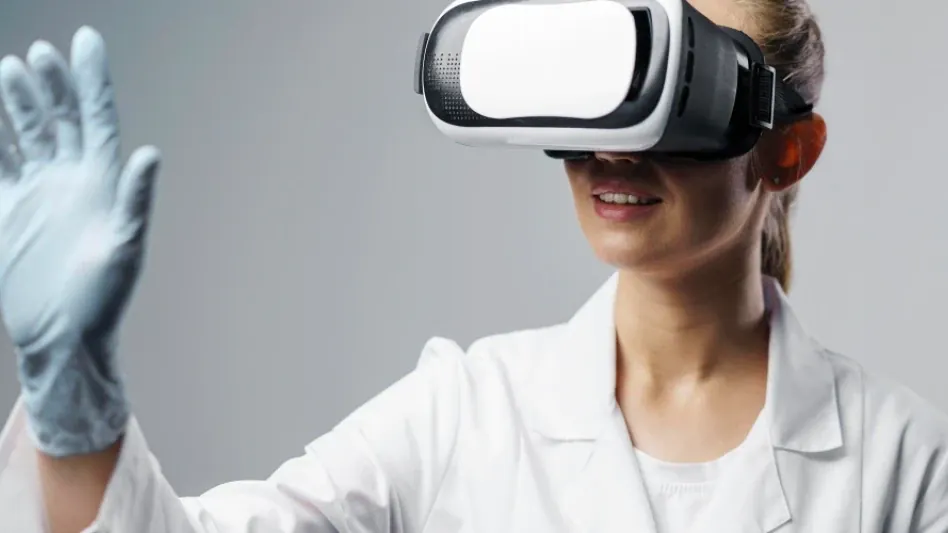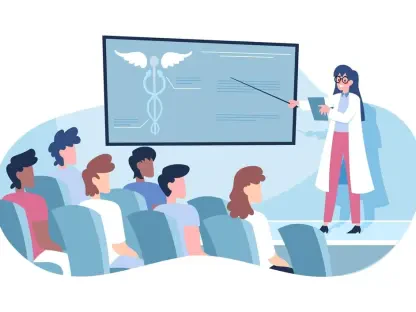The healthcare industry is undergoing a significant transformation driven by emerging technologies such as augmented and virtual reality (AR/VR), artificial intelligence (AI), and telehealth. These advancements are reshaping medical care, prevention, and patient experiences, presenting both opportunities and challenges for healthcare marketers. As technology continues to evolve, it is imperative for marketers to adapt and guide stakeholders through this dynamic landscape.
The Rise of AI in Healthcare
Enhancing Diagnostic Accuracy and Operational Efficiency
Artificial intelligence is revolutionizing healthcare by improving diagnostic accuracy and operational efficiency. AI algorithms are increasingly being used to analyze radiology images, detect anomalies, and assist in creating sophisticated diagnostic systems. This technological advancement is not only enhancing the precision of diagnoses but also streamlining workflows, allowing healthcare professionals to focus on patient care. The integration of AI in healthcare practices promotes quicker, more accurate decision-making, ultimately leading to better patient outcomes.
In radiology, AI algorithms analyze vast amounts of imaging data and pinpoint even the most subtle anomalies that might be missed by the human eye. This boosts the accuracy of diagnostics, which is crucial in critical scenarios such as detecting early-stage cancers. Additionally, AI-driven systems enhance operational efficiency by automating routine tasks, reducing the administrative burden on healthcare professionals, and enabling them to devote more time to direct patient care. This transformative technology offers the dual benefit of elevating the quality of healthcare while reducing costs and improving service delivery.
Market Projections and Growth
The global AI healthcare market is projected to grow exponentially, from $11 billion in 2021 to nearly $188 billion by 2030. This rapid growth underscores the critical shift toward technology-driven healthcare solutions. As AI continues to evolve, its applications in healthcare will expand, offering new opportunities for improving patient outcomes and operational efficiencies. This substantial market projection elucidates the movement toward the adoption of AI technologies to meet the rising demand for precision care and efficiency.
The future of AI in healthcare is not just an incremental change but a profound transformation. From predictive analytics that forecast disease outbreaks to personalized treatment plans based on genetic data, AI’s potential applications are diverse and expansive. These innovations position healthcare providers to offer more proactive and preventive care, optimizing resources and improving patient experiences. For healthcare marketers, this presents a golden opportunity to showcase the transformative impact of AI, fostering a narrative that is both innovative and patient-centric.
Addressing AI Bias and Data Privacy
Despite the promising potential of AI, there are inherent concerns regarding biases in AI algorithms and data privacy. Healthcare marketers must address these issues transparently, ensuring that stakeholders understand the measures taken to mitigate biases and protect patient data. By fostering trust and confidence in AI technologies, marketers can help drive their adoption and acceptance. The key to overcoming these challenges lies in clear and honest communication, demonstrating a commitment to ethical AI practices.
AI biases often stem from incomplete or non-representative data, which can lead to disparities in healthcare outcomes. Addressing these biases requires rigorous testing, validation, and continuous monitoring of AI algorithms to ensure they perform equitably across diverse patient populations. Additionally, data privacy is paramount in healthcare; marketing efforts must emphasize stringent data protection protocols and compliance with regulations such as HIPAA. By proactively addressing these concerns, healthcare marketers can build a foundation of trust that underpins the successful integration of AI into clinical practices.
The Emergence of VR in Healthcare
FDA Approval and Pain Management
Virtual reality is making significant strides in healthcare, with the FDA approving VR as a tool for managing chronic lower back pain. This approval highlights VR’s potential in pain management, labor, post-cancer treatment, and other medical applications. VR technology offers innovative ways to enhance patient interaction and treatment methodologies, providing immersive experiences that can improve patient outcomes. By simulating real-world scenarios and environments, VR can help patients manage pain better and support mental health treatments.
VR’s application in pain management is particularly notable. Chronic pain sufferers often face limited options for relief, and VR offers a non-invasive, drug-free alternative. The immersive nature of VR distracts patients and can alter their sensory perception, reducing the intensity of pain. Additionally, VR is proving beneficial in labor, providing mothers with a calming and distracting focus during childbirth. As healthcare providers explore these novel applications, VR’s role in enhancing patient care becomes increasingly significant.
Expanding Applications and Benefits
Beyond pain management, VR is being explored for various medical applications, including physical therapy, mental health treatment, and surgical training. These expanding applications demonstrate VR’s versatility and potential to revolutionize healthcare delivery. By leveraging VR technology, healthcare providers can offer more personalized and effective treatments, improving patient satisfaction and outcomes. In physical therapy, VR enables engaging and motivating recovery exercises, making the rehab process more enjoyable and efficient for patients.
Mental health treatment has also seen promising results with VR applications, such as exposure therapy for phobias, anxiety disorders, and PTSD. Patients can confront and manage their fears in a controlled, virtual environment, leading to significant improvements in mental well-being. Moreover, surgical training using VR provides a realistic, risk-free platform for surgeons to refine their skills, enhancing their proficiency and confidence. These varied applications underscore VR’s transformative potential in creating patient-centered, innovative healthcare solutions.
Marketing VR in Healthcare
Healthcare marketers play a crucial role in promoting the benefits of VR technology to both patients and providers. By educating stakeholders on the capabilities and advantages of VR, marketers can help drive its adoption and integration into healthcare practices. Clear and transparent communication is essential to address any skepticism and build trust in this emerging technology. Highlighting success stories and showcasing tangible benefits will be crucial in overcoming initial resistance and demonstrating VR’s profound impact.
To effectively market VR in healthcare, it is essential to emphasize its patient-centered benefits. This includes improved treatment outcomes, enhanced patient engagement, and greater accessibility to high-quality care. By positioning VR as a tool that enriches patient experiences and contributes to better health, marketers can create compelling narratives that resonate with diverse audiences. Providing educational resources, conducting demonstrations, and facilitating discussions with early adopters can further aid in building confidence and driving wider acceptance of VR.
Telehealth: Expanding Access to Care
Growth and Adoption During the Pandemic
The COVID-19 pandemic has accelerated the adoption of telehealth, making it a vital component of healthcare delivery. Telehealth has expanded access to care, allowing patients to receive medical consultations and treatments remotely. This shift has been particularly beneficial for individuals in rural or underserved areas, providing them with convenient and timely access to healthcare services. The pandemic highlighted telehealth’s potential to bridge healthcare gaps and ensure continuity of care when in-person visits were restricted.
The rapid adoption of telehealth during the pandemic demonstrates its ability to adapt to varying healthcare needs quickly. Patients with chronic conditions, mental health concerns, or those requiring urgent care could access medical services without leaving their homes. This convenience reduced the risk of exposure to the virus and eased the burden on overwhelmed healthcare facilities. As telehealth continues to evolve, it offers a sustainable solution for extending healthcare’s reach and improving patient outcomes, particularly in areas with limited healthcare infrastructure.
Benefits and Challenges
Telehealth offers numerous benefits, including increased convenience, reduced travel time, and improved access to specialists. However, it also presents challenges such as ensuring the security of patient data and maintaining the quality of care. Healthcare marketers must address these challenges by promoting the benefits of telehealth while ensuring that stakeholders understand the measures taken to safeguard patient information and maintain high standards of care. Emphasizing stringent security protocols and certifications can help alleviate concerns about data privacy and integrity.
Patient education is crucial to telehealth’s success. Marketers must ensure patients are well-informed about how telehealth works, including how to set up virtual appointments and what to expect during consultations. Addressing technological barriers, providing user-friendly platforms, and ensuring continuous support can enhance the telehealth experience. By highlighting the benefits, such as reduced wait times and access to a broader range of specialists, and addressing the potential challenges transparently, marketers can foster greater acceptance and adoption of telehealth services.
The Role of Marketers in Telehealth
As telehealth continues to evolve, healthcare marketers must play a proactive role in guiding patients and providers through this transformation. By highlighting the practical benefits of telehealth and addressing any concerns, marketers can help drive its adoption and integration into healthcare practices. Clear and transparent communication is essential to build trust and confidence in telehealth services. Marketers should focus on showcasing the successful outcomes of telehealth implementations and sharing patient testimonials to demonstrate its value.
Furthermore, cultivating partnerships with technology providers and healthcare institutions can enhance telehealth’s credibility and reach. Joint campaigns that showcase the seamless integration of technology and healthcare can provide reassurance to both patients and providers. Offering training sessions, webinars, and educational content can also empower healthcare professionals to leverage telehealth effectively. By advocating for telehealth’s advantages and responding to feedback, marketers can ensure that telehealth becomes an enduring component of modern healthcare delivery.
Navigating Market Competition
Established Giants and Agile Newcomers
The healthcare technology market is becoming increasingly competitive, with established giants like GE HealthCare and Philips pivoting to focus on AI and health tech. At the same time, agile newcomers and conglomerates such as Amazon and CVS are recognizing the lucrative prospects within the health tech domain. This dynamic ecosystem is driving innovation and pushing marketers to find new ways to gain and maintain consumer trust. For both established players and new entrants, staying relevant in this rapidly evolving landscape requires continuous adaptation and innovation.
Established companies with extensive industry experience leverage their vast resources and existing customer base to drive technological advancements. Their strong brand presence often facilitates smoother integration of new technologies into clinical practices. Conversely, agile newcomers introduce fresh perspectives and cutting-edge solutions, challenging traditional methods and fostering healthy competition. This competitive environment spurs marketing strategies that emphasize unique value propositions, highlight technological prowess, and demonstrate a commitment to improving patient care.
Building Trust in a Competitive Landscape
In a competitive market, building and maintaining trust is crucial for healthcare companies. Marketers must emphasize the human-centered benefits of new health technologies, addressing concerns such as AI biases and data privacy. By fostering strong connections with their audience and highlighting the tangible benefits of technological advancements, marketers can help their companies stand out in a crowded marketplace. Trust-building efforts should focus on transparency, reliability, and the consistent delivery of high-quality care.
Marketing strategies that humanize technology and emphasize its positive impact on patient care can foster deeper connections with consumers. This involves sharing real-life examples, success stories, and expert insights to illustrate how technology enhances health outcomes. Additionally, maintaining open lines of communication and actively seeking feedback can create a sense of inclusivity and reassure stakeholders that their needs and concerns are prioritized. In a competitive landscape, brands that prioritize building and maintaining trust are more likely to cultivate long-lasting relationships with their audience.
Long-Term Vision and Strategy
To navigate the competitive landscape, healthcare marketers must develop a long-term vision that integrates new technologies and addresses the evolving needs of their audience. By staying ahead of technological trends and continuously innovating, marketers can ensure their companies remain relevant and competitive. This forward-thinking approach will help build lasting relationships with stakeholders and drive the successful adoption of new healthcare technologies. Strategic planning that anticipates future advancements and market shifts is essential for sustained growth and differentiation.
A comprehensive long-term strategy involves aligning marketing efforts with broader organizational goals and technological roadmaps. Marketers should collaborate closely with research and development teams, healthcare professionals, and technology partners to stay abreast of emerging trends. This collaborative approach enables more accurate forecasting of market demands and better positioning of products and services. By proactively addressing industry challenges, such as regulatory changes and evolving patient expectations, marketers can craft campaigns that resonate with their audience and pave the way for successful technological integration.
Rebuilding Trust in Healthcare
Addressing Declining Faith in Healthcare Systems
The healthcare industry has faced significant challenges in maintaining public trust, exacerbated by recent events such as the COVID-19 pandemic and high-profile data breaches. Rebuilding this trust is paramount for healthcare marketers as technology continues to advance. Emphasizing the human-centered benefits of technological innovations and addressing concerns around data privacy and AI biases can help restore faith in healthcare systems. Transparent and empathetic communication is crucial in bridging the trust gap and fostering a sense of security among patients and stakeholders.
Healthcare marketers should focus on creating narratives that highlight the positive impact of new technologies on patient care and outcomes. By showcasing real-world examples and success stories, they can demonstrate how innovations enhance healthcare delivery and improve quality of life. Additionally, acknowledging past shortcomings and outlining concrete steps taken to mitigate future risks can reinforce a commitment to patient safety and data integrity. Rebuilding trust is a continuous effort that requires consistent, honest, and patient-centered communication.
Future Considerations and Actions
The healthcare sector is experiencing a profound transformation fueled by revolutionary technologies like augmented and virtual reality (AR/VR), artificial intelligence (AI), and telehealth. These innovations are revolutionizing medical care, healthcare prevention, and patient experiences, offering both opportunities and challenges for those in healthcare marketing. With the continuous evolution of technology, it is crucial for healthcare marketers to adapt to these changes. They must effectively communicate and steer stakeholders through this complex and ever-changing landscape. The integration of AR/VR allows for more immersive patient education, while AI can significantly enhance diagnostics and predictive analytics, leading to personalized treatment plans. Telehealth, on the other hand, has revolutionized the way patients and healthcare providers interact, offering greater access and convenience. Ultimately, to succeed in this dynamic environment, marketers need to stay abreast of technological advancements and leverage them to improve healthcare delivery and patient satisfaction.









